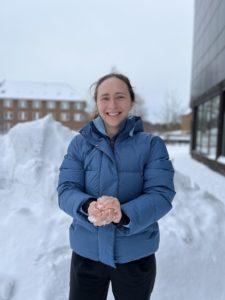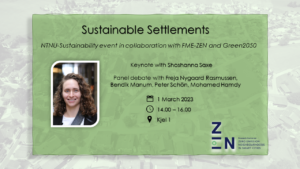
Curious about Zero Emission Neighbourhoods
Meet Shoshanna Saxe, associate professor in civil engineering in Toronto, Canada. She is currently on sabbatical at NTNU, Trondheim.


What is your area of research?
– In Toronto, I am researching the built environment and infrastructure. I am very interested in the relationship between the physical world we build, and sustainable outcomes. Specifically, I focus on two questions: what we should build: how to decide what the right projects are, and how do we develop the decision-making process. And then when we have decided to build, how should we technically assure that the project lives up to sustainability?
Shoshanna has been in academia for years, but has also worked for a consultant company, where she realized that she was more interested in questions on how to do things differently, than safely deliver results on time and to the right price.
– The most interesting question I know is how should we build the world? We get the world we build. We can choose different solutions – but we have not been good at it so far. How to build sustainability for them, she asks.
Why did you choose NTNU as a place to be for your sabbatical?
– I knew that NTNU does a lot of research on sustainability. But I don’t know many of the researchers here, so I want to get to know as many of you as possible during my stay. I have worked with Edgar Hertwich before, so he is the link that got me here. And I am also going to be around FME ZEN.
Back in Toronto she has just started a new research center called “Centre for the sustainable built environment”. – Here we are looking at the tension between the social and economic pressure to build more houses and infrastructure and our climate commitments. For example: In Canada the population is growing very fast; we are most likely to double our population in my lifetime. And all these people need houses and everything that follows such as infrastructure, schools, shops, and community services. In my region our government are going to build 1,5 million homes in the next ten years. That is more construction in a decade than we have ever seen.
But from a technological and materials perspective 10 years is short, we will build these new homes with pretty much the technology we have today. We need to ask how we change the ways we are building to minimize the environmental cost of that necessary social construction. There are the questions we ask ourselves in the center, and we hope our findings will influence policymakers as well as construction- and design processes. Canada is 10-15 years behind Europe in awareness about sustainability and construction, for example embodied carbon. There is a lot of room for learning now – and people are willing.
She finds the focus on a neighborhood scale in Zero Emission Neighborhoods interesting: because it is less common to see. – We tend to do single things in buildings and on energy systems but not at a neighborhood level.
What else are you going to do apart from academic work while in Norway?
– I am here to meet, listen, learn, and be in a different time zone than my work back home. But one of my non-academic goals is to skate on natural ice. And I am taking some cross-country ski lessons. At home, I am more of a downhill person.
She is also attending the Sustainable Settlements – seminar on the 1th of March at Kjelhuset 1 in Campus Gløshaugen, Trondheim.


Other news
ZEN pilot project Zero Village Bergen. ©Bergen Municipality

































